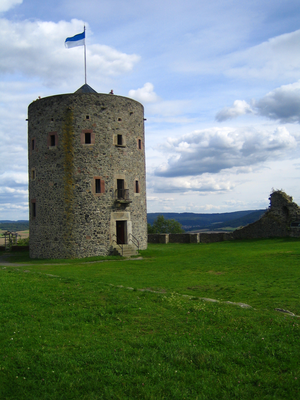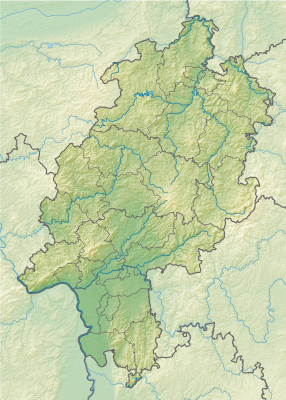Hohenburg (Homberg)
| Hohenburg | ||
|---|---|---|
|
Lookout tower on the Hohenburg |
||
| Alternative name (s): | Homberg | |
| Creation time : | before 1190 | |
| Castle type : | Hilltop castle | |
| Conservation status: | Keep, curtain wall, kennel, gate | |
| Standing position : | Nobles, counts | |
| Place: | Homberg on the Efze | |
| Geographical location | 51 ° 2 '11.9 " N , 9 ° 24' 22.2" E | |
| Height: | 376.5 m above sea level NHN | |
|
|
||
The Hohenburg , also called Homberg , is the ruin of a hilltop castle in Homberg (Efze) in the Schwalm-Eder district in Northern Hesse .
Geographical location
The Hohenburg ruin is located in the core town of Homberg on the wooded Schloßberg ( 376.5 m above sea level ), a basalt cone rising steeply from the Efze aue south of the mountain , which is surrounded to the west, south and east by the built-up areas of the city is.
Homberg was at the intersection of two historical trade routes, the road from Fritzlar via Homberg to Hersfeld and the Langen Hessen . The location was therefore of great strategic importance.
history

By whom and when the castle was built is not known. In 1162, however, a "Rentwich von Hohenburg" was first mentioned in a document, this family died in 1427 with "Simon vom Hohenberg". From around 1190 it was owned by the Landgraviate of Thuringia . The castle was first mentioned in documents in 1246. Together with the city, it formed a unit and was of great importance on the old trade route Frankfurt-Leipzig.
In the 13th century it came under Landgrave Heinrich I to the newly created Landgraviate of Hesse . It became the administrative center of the Homburg office . In 1508 the brother of the Hessian Landgrave Ludwig II of Niederhessen , Archbishop Hermann IV of Cologne , owned the castle and had it extensively rebuilt. A bronze plaque that was found during excavation work at the castle bears the inscription: “Herman von Gotzes mercy Erzbyschoff zu Colne, the holy romschyn rich through Ytalia, Ertzcantzler, Elector, Duke of West Valn and Engern, of the Abbey of Paderborn, Administrator A ( nno) 1508 ". The bronze plate is in the Homberg local history museum . It is characterized by remarkable chasing and is adorned with the archbishop's and landgrave's coat of arms.
From 1605 to 1613, Landgrave Moritz had the re-exposed castle well, which is 150 meters deep and is one of the deepest wells in Germany, built for 25,000 thalers, and the castle was further strengthened.
The Landgraves of Hessen-Kassel initially maintained neutrality during the Thirty Years' War until 1631. From 1634 the war was carried into Hesse. On July 16, 1636, the city of Homberg was occupied by imperial troops. The siege of the castle by General Johann von Götzen with an imperial army of 13,000 men was successfully repulsed. With a new siege on August 3, 1636, the castle garrison had to surrender due to a lack of water supply. The citizens of the city could not meet the contribution demands of Colonel Tirell. Thereupon this city and castle burned down.
Sergeant General Rabenhaupt besieged the castle from January 28th to 30th, 1648 and was able to recapture it for the Landgraviate of Hesse-Kassel . On February 9, 1648 there was another surrender.
The heavily destroyed castle fell into disrepair and was partially used as a quarry for the reconstruction of the likewise heavily destroyed town of Homberg. Many components of the former castle can still be found in the cityscape today.
Todays use
In 1822 the ruins came into the possession of the city of Homberg. Since 1936 it has been exposed, restored and looked after by a castle association. A keep was built on old foundations from 1952 to 1958 . This was not built according to the historical model. The castle fountain was exposed from 1997 to 2001.
There is a restaurant on the grounds of the outer bailey. A castle tower serves as a lookout tower with a view of Homberg and its surroundings.
investment
The formerly very extensive castle complex had a small outer bailey ( Zwinger ) with an outer castle gate, a drawbridge over the moat and outer bastions, connected via a gate tower with battlements to the main castle and entrance to the castle chapel . The castle also had a round keep , a palas with a knight's hall, a well house with a 150 m deep castle well (third deepest castle well in Germany), a stables , military accommodation, a gun house, an arsenal, a gun bay, commandant's house and stair tower . The curtain wall had a wall thickness of 1.5 meters.
The massive castle tower with a diameter of 11 meters and a height of 14 meters is not part of the historical inventory, but was built as a lookout tower in the style of old keep by the castle mountain community from 1952 to 1958.
Individual evidence
literature
- Axel W. Gleue: How did the water get to the castle? From well construction to hilltop castles and mountain vests. Schnell & Steiner, Regensburg 2008. ISBN 978-3-7954-2085-7
- Rudolf Knappe: Medieval castles in Hessen. 800 castles, castle ruins and fortifications. 3. Edition. Wartberg-Verlag, Gudensberg-Gleichen 2000, ISBN 3-86134-228-6 , p. 93.
- Frank Lindekamm u. Heinz home: The Hohenburg zu Homberg (Efze) from the Middle Ages to the present. A historical reconstruction in pictures and words. Wartberg Verlag, Gudensberg-Gleichen 2010. ISBN 978-3-8313-2235-0
- Rolf Müller (Ed.): Palaces, castles, old walls. Published by the Hessendienst der Staatskanzlei, Wiesbaden 1990, ISBN 3-89214-017-0 , pp. 189–191.
Web links
- Entry by Stefan Eismann zu Hohenburg in Homburg ad Efze in the scientific database " EBIDAT " of the European Castle Institute
- History of Hohenburg Castle and the Castle Association.
- Digital reconstruction of Hohenburg Castle



